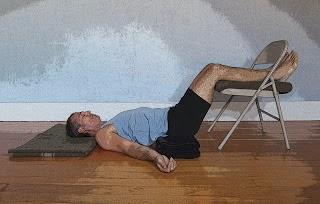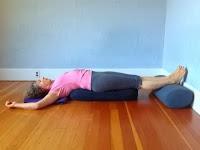SO... do you have any suggestions as to what yoga poses would be good for this situation or any other advice?
A: The first thing that jumps out at me is that she only has edema in one leg. Given the fact that she has had this condition for four years now, I’d have to assume she has seen her doctor and has undergone a thorough work-up to figure out the underlying problem causing such significant swelling. It would not be a bad idea, if you feel comfortable asking, to find out if there is a diagnosis, as it could impact how you would address the problem with yoga asana.
As some background, the Mayo Clinic website has this to say about leg swelling, or edema:
“Leg swelling can occur in any part of the legs, including the feet, ankles, calves or thighs. Leg swelling can result either from fluid buildup (fluid retention) or from inflammation in injured or diseased tissues or joints.
“Many of the causes of leg swelling, such as prolonged standing or sitting or an injury, are relatively harmless in the long term, and your doctor often can easily identify the reason for the problem. Sometimes, however, leg swelling may be a sign of a more serious disorder, such as heart disease or a blood clot. It's important to seek prompt diagnosis and treatment when leg swelling occurs for no apparent reason or is accompanied by apparently unrelated symptoms, such as breathing difficulties or chest pain.”
The list of possible underlying causes is quite impressive and is likely to be a bit overwhelming to the layperson, but for those interested, this Mayo Clinic article on Leg Swelling has that list. The site gives a nice explanation for how the body deals with trying to maintain normal fluid balance in the body:
“Leg swelling caused by the buildup of fluids in leg tissues is known as peripheral edema. Several body systems help maintain the appropriate balance of fluids, including the circulatory system, the lymphatic system and the kidneys. A problem with any one of these systems may contribute to the buildup of fluids. Gravity can also contribute to the accumulation of fluids in your lower limbs, particularly with prolonged standing or sitting."
When there is swelling in only one limb, the causes of the swelling can be different than when both legs or all limbs are involved. In my experience, I have had quite a number of students with swelling in just one arm following surgical treatment for breast cancer. As part of the surgery, several lymph glands are removed from the armpit area, the axilla, to see if the cancer has spread beyond the breast. As a side effect, the normal return flow of lymph fluid from the fingers to the heart is disrupted and leads to chronic swelling on the affected side. There are other causes of one limb swelling, as outlined from the website Healthline.com:
“Some conditions that may cause swelling in just one leg include:
- Blood clots. Clots can cause pooling of fluid and may be accompanied by discoloration and pain. In some instances, clots may cause no pain.
- Weakened veins. Varicose veins, or veins whose walls or valves are weak, can allow blood to pool in the legs. This is a common condition.
- Infection and inflammation. Infection in leg tissues can cause inflammation and increased blood flow to the area. Inflammatory diseases, such as gout or arthritis, can also result in swelling.
- Lymphedema. Blocked lymph channels may be caused by infection, scar tissue, or hereditary conditions. Lymph that can't drain properly results in edema. Lymphedema may also occur after cancer treatments, when the lymph system is impaired by surgery, radiation, or chemotherapy.
- Tumor. Abnormal masses can compress blood vessels and lymph channels, affecting the rate of fluid movement.”
 The restorative version of Bridge Pose, where the shoulders and head are on the floor and the torso and legs are supported on two bolsters positioned lengthwise, will also assist in the return of fluid in the legs toward the heart. See All About Supported Inverted Poses for other ideas.
The restorative version of Bridge Pose, where the shoulders and head are on the floor and the torso and legs are supported on two bolsters positioned lengthwise, will also assist in the return of fluid in the legs toward the heart. See All About Supported Inverted Poses for other ideas. Active use of the leg muscles normally assists the return of blood and lymph fluid from the feet towards the pelvis, as the contraction and relaxation of the leg muscles helps to pump the fluids against gravity in their respective vessels, be they veins or lymph vessels. So some gentle movement practices would also be of potential benefit. Examples include our Dynamic Reclined Hip Stretches, dynamic standing poses such as Warrior 2 Mini Vinyasa, or a modified easy Sun or Moon Salutation. That should give you both a good start. Please let us know how things proceed!
Active use of the leg muscles normally assists the return of blood and lymph fluid from the feet towards the pelvis, as the contraction and relaxation of the leg muscles helps to pump the fluids against gravity in their respective vessels, be they veins or lymph vessels. So some gentle movement practices would also be of potential benefit. Examples include our Dynamic Reclined Hip Stretches, dynamic standing poses such as Warrior 2 Mini Vinyasa, or a modified easy Sun or Moon Salutation. That should give you both a good start. Please let us know how things proceed!—Baxter

